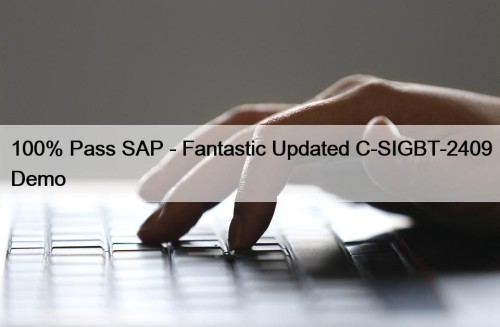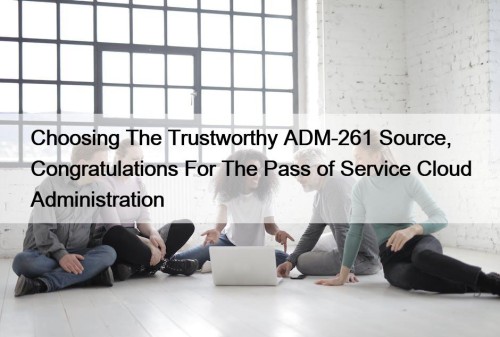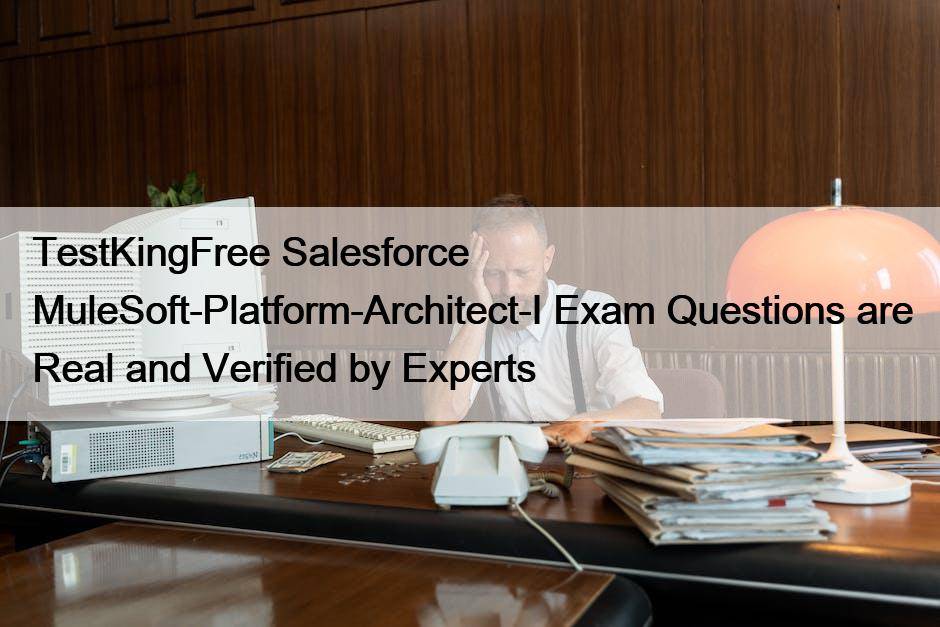Most Popular
 100% Pass SAP - Fantastic Updated C-SIGBT-2409 Demo
100% Pass SAP - Fantastic Updated C-SIGBT-2409 Demo
As the authoritative provider of C-SIGBT-2409 guide training, we can ...
 Choosing The Trustworthy ADM-261 Source, Congratulations For The Pass of Service Cloud Administration
Choosing The Trustworthy ADM-261 Source, Congratulations For The Pass of Service Cloud Administration
To cope with the fast growing market, we will always ...
 Full fill Your Goals by Achieve the Amazon DOP-C02 Certification
Full fill Your Goals by Achieve the Amazon DOP-C02 Certification
BONUS!!! Download part of Pass4sureCert DOP-C02 dumps for free: https://drive.google.com/open?id=1II_ZzPC6-7BMat3atRZ1PHd-Xhc1XNFHIf ...



TestKingFree Salesforce MuleSoft-Platform-Architect-I Exam Questions are Real and Verified by Experts

With many advantages such as immediate download, simulation before the real exam as well as high degree of privacy, our MuleSoft-Platform-Architect-I actual exam survives all the ordeals throughout its development and remains one of the best choices for those in preparation for MuleSoft-Platform-Architect-I Exam. Many people have gained good grades after using our MuleSoft-Platform-Architect-I real dumps, so you will also enjoy the good results. Don’t hesitate any more. Time and tide wait for no man. Come and buy our MuleSoft-Platform-Architect-I exam questions!
Salesforce MuleSoft-Platform-Architect-I Exam Syllabus Topics:
| Topic | Details |
|---|---|
| Topic 1 |
|
| Topic 2 |
|
| Topic 3 |
|
| Topic 4 |
|
| Topic 5 |
|
| Topic 6 |
|
| Topic 7 |
|
>> Vce MuleSoft-Platform-Architect-I Format <<
Newest MuleSoft-Platform-Architect-I - Vce Salesforce Certified MuleSoft Platform Architect I Format
In fact, passing MuleSoft-Platform-Architect-I certification exam is just a piece of cake! But in realistic society, some candidates always say that this is difficult to accomplish. Therefore, MuleSoft-Platform-Architect-I certification has become a luxury that some candidates aspire to. When the some candidates through how many years attempted to achieve a goal to get MuleSoft-Platform-Architect-I Certification, had still not seen success hope, candidate thought always depth is having doubts unavoidably bog: can I get MuleSoft-Platform-Architect-I certification? When can I get MuleSoft-Platform-Architect-I certification? In this a succession of question behind, is following close on is the suspicion and lax.
Salesforce Certified MuleSoft Platform Architect I Sample Questions (Q28-Q33):
NEW QUESTION # 28
Refer to the exhibits.
Which architectural constraint is compatible with the API-led connectivity architectural style?
- A. Handle customizations for the end-user application at the Process layer rather than at the Experience layer
- B. Always use a tiered approach by creating exactly one API for each of the three layers (Experience, Process, and System)

- C. Allow System APIs to return data that is not currently required by the identified Process or Experience APIs

- D. Use a Process API to-orchestrate calls to multiple System APIs but not to other Process APIs:
Answer: D
Explanation:
Understanding API-led Connectivity Layers:
In MuleSoft's API-led connectivity approach, APIs are categorized into three layers:
Experience Layer: This layer is responsible for providing data to the end-user applications and is often customized to meet the needs of different user interfaces.
Process Layer: This layer is used to orchestrate and combine data from multiple System APIs. It acts as a mediator and business logic layer without directly interacting with the backend systems.
System Layer: This layer provides direct access to the backend systems (e.g., databases, ERPs) and is usually focused on exposing atomic data operations.
Evaluating the Architectural Constraints:
Option A: Always using a strict tiered approach by creating exactly one API per layer is not necessarily an architectural constraint of API-led connectivity. While a layered approach is recommended, it is common to have multiple APIs in each layer as needed for different functionalities.
Option B (Correct Answer): In API-led connectivity, Process APIs are generally responsible for orchestrating calls to System APIs and should not call other Process APIs. This maintains a clear separation of concerns, ensuring that Process APIs aggregate data from System APIs only and provide it to Experience APIs.
Option C: System APIs are generally designed to provide only the necessary data to meet current business requirements. Allowing them to return extra data that is not needed by Process or Experience APIs is not a best practice, as it can lead to inefficiencies.
Option D: Customizations specific to end-user applications are typically handled at the Experience Layer rather than the Process Layer, as the Experience Layer is intended to tailor the data to fit the needs of each specific client or front-end application.
Conclusion:
Option B is the correct answer as it aligns with the API-led connectivity principles. In this architectural style, Process APIs should orchestrate System APIs but should avoid interacting with other Process APIs to keep a clear separation of responsibilities across the layers.
For additional details, refer to MuleSoft documentation on API-led connectivity best practices, particularly around the roles of each layer in API orchestration and data handling.
NEW QUESTION # 29
When could the API data model of a System API reasonably mimic the data model exposed by the corresponding backend system, with minimal improvements over the backend system's data model?
- A. When there is an existing Enterprise Data Model widely used across the organization
- B. When the System API can be assigned to a bounded context with a corresponding data model
- C. When the corresponding backend system is expected to be replaced in the near future
- D. When a pragmatic approach with only limited isolation from the backend system is deemed appropriate
Answer: D
Explanation:
Correct Answer : When a pragmatic approach with only limited isolation from the backend system is deemed appropriate.
*****************************************
General guidance w.r.t choosing Data Models:
>> If an Enterprise Data Model is in use then the API data model of System APIs should make use of data types from that Enterprise Data Model and the corresponding API implementation should translate between these data types from the Enterprise Data Model and the native data model of the backend system.
>> If no Enterprise Data Model is in use then each System API should be assigned to a Bounded Context, the API data model of System APIs should make use of data types from the corresponding Bounded Context Data Model and the corresponding API implementation should translate between these data types from the Bounded Context Data Model and the native data model of the backend system. In this scenario, the data types in the Bounded Context Data Model are defined purely in terms of their business characteristics and are typically not related to the native data model of the backend system. In other words, the translation effort may be significant.
>> If no Enterprise Data Model is in use, and the definition of a clean Bounded Context Data Model is considered too much effort, then the API data model of System APIs should make use of data types that approximately mirror those from the backend system, same semantics and naming as backend system, lightly sanitized, expose all fields needed for the given System API's functionality, but not significantly more and making good use of REST conventions.
The latter approach, i.e., exposing in System APIs an API data model that basically mirrors that of the backend system, does not provide satisfactory isolation from backend systems through the System API tier on its own. In particular, it will typically not be possible to "swap out" a backend system without significantly changing all System APIs in front of that backend system and therefore the API implementations of all Process APIs that depend on those System APIs! This is so because it is not desirable to prolong the life of a previous backend system's data model in the form of the API data model of System APIs that now front a new backend system. The API data models of System APIs following this approach must therefore change when the backend system is replaced.
On the other hand:
>> It is a very pragmatic approach that adds comparatively little overhead over accessing the backend system directly
>> Isolates API clients from intricacies of the backend system outside the data model (protocol, authentication, connection pooling, network address, ...)
>> Allows the usual API policies to be applied to System APIs
>> Makes the API data model for interacting with the backend system explicit and visible, by exposing it in the RAML definitions of the System APIs
>> Further isolation from the backend system data model does occur in the API implementations of the Process API tier
NEW QUESTION # 30
Say, there is a legacy CRM system called CRM-Z which is offering below functions:
1. Customer creation
2. Amend details of an existing customer
3. Retrieve details of a customer
4. Suspend a customer
- A. Implement different system APIs named createCustomerInCRMZ, amendCustomerInCRMZ, retrieveCustomerFromCRMZ and suspendCustomerInCRMZ as they are modular and has seperation of concerns
- B. Implement different system APIs named createCustomer, amendCustomer, retrieveCustomer and suspendCustomer as they are modular and has seperation of concerns
- C. Implement a system API named customerManagement which has all the functionalities wrapped in it as various operations/resources
Answer: B
Explanation:
Correct Answer : Implement different system APIs named createCustomer, amendCustomer, retrieveCustomer and suspendCustomer as they are modular and has seperation of concerns
*****************************************
>> It is quite normal to have a single API and different Verb + Resource combinations. However, this fits well for an Experience API or a Process API but not a best architecture style for System APIs. So, option with just one customerManagement API is not the best choice here.
>> The option with APIs in createCustomerInCRMZ format is next close choice w.r.t modularization and less maintenance but the naming of APIs is directly coupled with the legacy system. A better foreseen approach would be to name your APIs by abstracting the backend system names as it allows seamless replacement/migration of any backend system anytime. So, this is not the correct choice too.
>> createCustomer, amendCustomer, retrieveCustomer and suspendCustomer is the right approach and is the best fit compared to other options as they are both modular and same time got the names decoupled from backend system and it has covered all requirements a System API needs.
NEW QUESTION # 31
What Anypoint Connectors support transactions?
- A. Database, JMS, VM
- B. Database, JMS, VM, SFTP
- C. Database, 3MS, HTTP
- D. Database, VM, File
Answer: A
NEW QUESTION # 32
A Mule 4 API has been deployed to CloudHub and a Basic Authentication - Simple policy has been applied to all API methods and resources. However, the API is still accessible by clients without using authentication.
How is this possible?
- A. The APE Router component is pointing to the incorrect Exchange version of the APT
- B. One of the application's CloudHub workers restarted
- C. No... for client applications have been created of this API
- D. The Autodiscovery element is not present, in the deployed Mule application
Answer: D
Explanation:
When a Basic Authentication policy is applied to an API on CloudHub but clients can still access the API without authentication, the likely cause is a missing Autodiscovery element. Here's how this affects API security:
Autodiscovery in MuleSoft:
The Autodiscovery element is essential for linking an API implementation deployed in CloudHub with its API instance defined in API Manager. This connection allows the policies applied in API Manager, such as Basic Authentication, to be enforced on the deployed API.
Why Option B is Correct:
Without Autodiscovery, the deployed application does not "know" about the policies configured in API Manager, resulting in unrestricted access. Adding Autodiscovery enables the API to enforce the policies correctly.
of Incorrect Options:
Option A (incorrect Exchange version) would not cause bypassing of security policies.
Option C (missing client applications) does not impact authentication policy enforcement.
Option D (worker restart) is irrelevant to policy enforcement.
Reference
Refer to MuleSoft documentation on Autodiscovery configuration and linking API Manager policies for additional information on setting up secure API policies.
NEW QUESTION # 33
......
We are all ordinary human beings. Something what have learned not completely absorbed, so that wo often forget. When we need to use the knowledge we must learn again. When you see TestKingFree's Salesforce MuleSoft-Platform-Architect-I Exam Training materials, you understand that this is you have to be purchased. It allows you to pass the exam effortlessly. You should believe TestKingFree will let you see your better future. Bright hard the hard as long as TestKingFree still, always find hope. No matter how bitter and more difficult, with TestKingFree you will still find the hope of light.
MuleSoft-Platform-Architect-I Reliable Dumps Free: https://www.testkingfree.com/Salesforce/MuleSoft-Platform-Architect-I-practice-exam-dumps.html
- Pass Guaranteed Quiz 2025 Trustable Salesforce MuleSoft-Platform-Architect-I: Vce Salesforce Certified MuleSoft Platform Architect I Format 🗣 Enter ☀ www.exam4pdf.com ️☀️ and search for 《 MuleSoft-Platform-Architect-I 》 to download for free 🎣Valid MuleSoft-Platform-Architect-I Exam Test
- Exam MuleSoft-Platform-Architect-I Score 🛌 MuleSoft-Platform-Architect-I Valid Test Discount ⛰ MuleSoft-Platform-Architect-I Valid Mock Exam 🪓 Simply search for ⏩ MuleSoft-Platform-Architect-I ⏪ for free download on 《 www.pdfvce.com 》 😃MuleSoft-Platform-Architect-I Training Pdf
- Salesforce Vce MuleSoft-Platform-Architect-I Format - Correct MuleSoft-Platform-Architect-I Reliable Dumps Free and Verified Salesforce Certified MuleSoft Platform Architect I Exam Pass4sure 🧭 Open ➡ www.pass4leader.com ️⬅️ and search for 【 MuleSoft-Platform-Architect-I 】 to download exam materials for free 🏊MuleSoft-Platform-Architect-I Reliable Test Questions
- Reliable MuleSoft-Platform-Architect-I Study Materials 🆖 MuleSoft-Platform-Architect-I Updated Testkings 💂 New MuleSoft-Platform-Architect-I Test Question 🛸 Open ▛ www.pdfvce.com ▟ and search for 《 MuleSoft-Platform-Architect-I 》 to download exam materials for free ✔MuleSoft-Platform-Architect-I Valid Mock Exam
- Reliable MuleSoft-Platform-Architect-I Study Materials ♥ New MuleSoft-Platform-Architect-I Test Test 🤞 Reliable MuleSoft-Platform-Architect-I Study Materials 🔒 Simply search for “ MuleSoft-Platform-Architect-I ” for free download on ➠ www.passtestking.com 🠰 🛶MuleSoft-Platform-Architect-I Exam Guide Materials
- Exam MuleSoft-Platform-Architect-I Score 🍔 New MuleSoft-Platform-Architect-I Test Test 🥨 Valid MuleSoft-Platform-Architect-I Exam Test 😆 Download ⇛ MuleSoft-Platform-Architect-I ⇚ for free by simply searching on ▛ www.pdfvce.com ▟ 🍐MuleSoft-Platform-Architect-I Valid Test Discount
- Latest updated Vce MuleSoft-Platform-Architect-I Format - The Best Assstant to help you pass MuleSoft-Platform-Architect-I: Salesforce Certified MuleSoft Platform Architect I 🏭 Copy URL ⏩ www.torrentvalid.com ⏪ open and search for ➡ MuleSoft-Platform-Architect-I ️⬅️ to download for free 🧞MuleSoft-Platform-Architect-I Exam Guide Materials
- Valid MuleSoft-Platform-Architect-I Exam Test 🎎 MuleSoft-Platform-Architect-I Test Answers 🍣 Pass MuleSoft-Platform-Architect-I Rate 🐌 Search for ➤ MuleSoft-Platform-Architect-I ⮘ and download it for free immediately on ▷ www.pdfvce.com ◁ 🥰MuleSoft-Platform-Architect-I Reliable Test Materials
- MuleSoft-Platform-Architect-I Real Questions, MuleSoft-Platform-Architect-I Practice Exam, MuleSoft-Platform-Architect-I PDF VCE 👳 Open website ⇛ www.prep4away.com ⇚ and search for ( MuleSoft-Platform-Architect-I ) for free download 🛺MuleSoft-Platform-Architect-I Valid Test Discount
- MuleSoft-Platform-Architect-I Valid Exam Guide 🎺 Upgrade MuleSoft-Platform-Architect-I Dumps 🟢 New MuleSoft-Platform-Architect-I Test Test 📑 Easily obtain ✔ MuleSoft-Platform-Architect-I ️✔️ for free download through ⏩ www.pdfvce.com ⏪ 🤒New MuleSoft-Platform-Architect-I Test Question
- MuleSoft-Platform-Architect-I Test Answers 💷 New MuleSoft-Platform-Architect-I Test Test 🐴 MuleSoft-Platform-Architect-I Exam Guide Materials 🛄 Immediately open 「 www.examsreviews.com 」 and search for ▛ MuleSoft-Platform-Architect-I ▟ to obtain a free download 🎪MuleSoft-Platform-Architect-I Reliable Test Materials
- MuleSoft-Platform-Architect-I Exam Questions
- capitalchess.net ilmacademyedu.com www.scoaladeyinyoga.ro greatlightchurch.co.za mathematicsoutlet.com kalambeflos.com wealthacademyafrica.com liberationmeditation.org 25000n-02.duckart.pro pcoseru.co.uk
Tags: Vce MuleSoft-Platform-Architect-I Format, MuleSoft-Platform-Architect-I Reliable Dumps Free, MuleSoft-Platform-Architect-I Exam Pass4sure, Regualer MuleSoft-Platform-Architect-I Update, MuleSoft-Platform-Architect-I Best Study Material